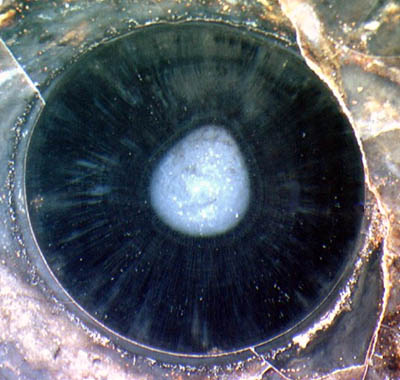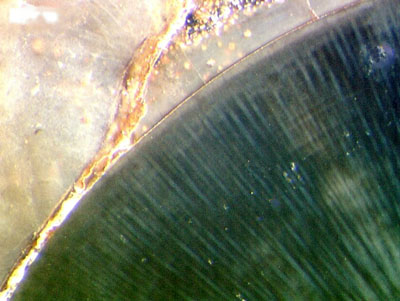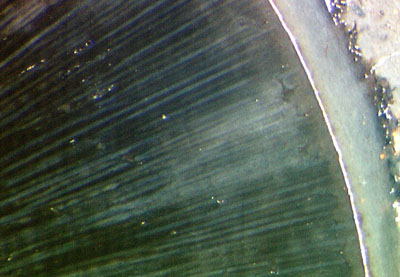
Enigmatic little sphere
Among the numerous circular sections of the well-known Rhynie chert
plants usually seen on cut and polished faces of the chert samples, one
particular circular section on a sample found in 2003 looks different
(Fig.1): It does not show the usual structure of cellular tissue with a
central strand but radially arranged tubes instead. It has turned out
to be not a cross section of a plant shoot or axis but of a little
sphere of about 4mm diameter incidentally cut right through the centre.
Fossil spheres of this type, called Pachytheca, have
been known for a
long time as carbonaceous fossils in Upper Silurian and Lower Devonian
sediments from several places [1] but never in chert.

Fig.1: Cross-section of the enigmatic sphere Pachytheca made up
of radially arranged tubes. Diameter
3.8mm. Photographs:
H. Sahm.
Note the cracks not entering but running along the surface
of the sphere,
possibly indicating the presence of a waxy layer or cuticle.
Nothing is left of the tangle of tubes usually present in the centre.
Sample: Rh11/1.1, found in 2003.
Fig.2: Cross-section of
Pachytheca,
detail
from Fig.1.
Note the well-defined smooth surface, the concentric bands below it,
and the forking tubes.
In early publications, the nature of Pachytheca
had been a subject of wild speculation. More recently, it
was regarded as an unsuccessful attempt of Green Algae trying to adapt
to terrestrial
life. This would make sense in view of the
fact that the structure is optimized for minimum water loss. However,
the alga connection apparently proved unsubstantiated so that it was
cautiously placed under the heading
"Enigmatic
Plants". As it has some features in common
with the nematophytes, which, still more cautiously, are called
"Enigmatic Organisms" now, it has been placed there [2], which makes it
all the more fascinating.
Among that much uncertainty it seems to be
certain that Pachytheca
is a terrestrial organism. This
assumption is confirmed by peculiar crack
paths in the present specimen: Cracks propagating towards the sphere do
not
traverse it but are deflected into a path along the surface. From this
observation it can be concluded that the surface is a mechanically weak
face in the chalcedony as it is often brought about by the presence of
a waxy coating or cuticle covering the surface of land plants as
a protection against exsiccation.
Like the filaments of other nematophytes, those of Pachytheca appear
as tubes not subdivided into cells (Fig.2). The
tubes are clearly seen forking, a feature not distinctly seen with
other
nematophytes.

Fig.3: Cross-section of Pachytheca,
detail
from Fig.1.
Note the well-defined smooth surface, straight and
forking tubes, and irregular-shaped cavities
apparently due to damage in gel between the tubes.
The thick
coating on the surface is probably a microbial layer.
The
aspect of the concentric bands faintly seen
in the photographs,
particularly in some places in Fig.2, suggests
that these bands may not be a feature of the tubes
but of the space in between. This and the cavities seen in Fig.3 seem
to indicate the presence of gel between the tubes. This
would
be the first evidence for the presence of gel in Pachytheca.
Observations on
other nematophyte species in the Rhynie chert also suggest a
consistence as jelly with filaments inside. Hence, jelly inside Pachytheca
is compatible with the
interpretation as a nematophyte. Also the presence of gel would
easily explain the smooth surface of Pachytheca, and the
concentric
bands could be interpreted as the positions of older gel surfaces which
became overgrown, which means they could be called growth rings, or
rather growth spheres in this case.
Despite of some information derived from this
well preserved specimen in the Rhynie
chert, Pachytheca
remains an enigmatic organism.
H.-J. Weiss 2004,
updated 2010
[1]
H.
Steur:
Pachytheca,
a strange, vegetable little sphere.
http://www.xs4all.nl/~steurh/
[2] T.N. Taylor,
E.L.
Taylor,
M. Krings: Paleobotany, Elsevier 2009.
[3]
H. Steur:
Pachytheca,
een
vreemd, plantaardig bolletje uit het Devoon, Grondboor
& Hamer 58(2004), 52-57.
Annotation: This specimen
was first presented at the 3rd Chert
Workshop, Chemnitz 2004, and a first version of this contribution,
based on the
now obsolete view of a relationship to Green Algae, was submitted to
www.kieseltorf.de then. In
connection with the current interpretation of Pachytheca as a nematophyte and the highly probable
presence of gel inside, the
idea of water uptake by capillary action put forward in the first
version is retracted herewith. See also Rhynie
Chert News 36, 44.
A few more photographs of this
specimen by H.
Sahm
have been attached to a more comprehensive presentation
on Pachytheca
by H. Steur
[1].
For more references see [1,3].
 |
 |
1 |






